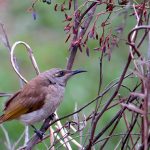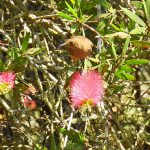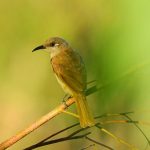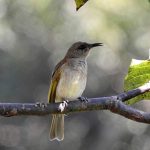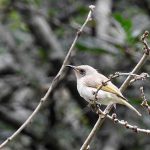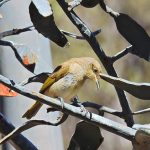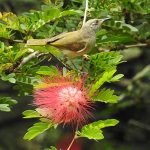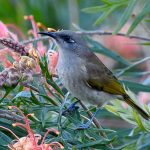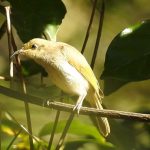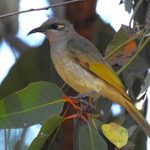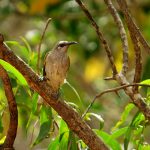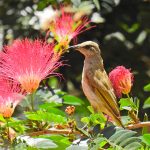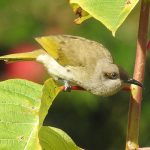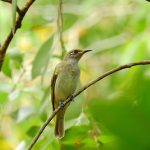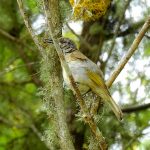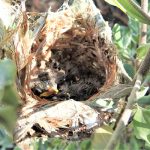BROWN HONEYEATER
Brown Honeyeater
In the first wash of morning light, a paperbark swamp breathes out the sweet, tea‑like scent of Melaleuca blossom. From the tangle of grey bark and white flowers comes a clear, ringing note — a sharp “tsee!” followed by an eager cascade of whistles. A Brown Honeyeater springs from twig to twig, tail flicking, bill dipped into a froth of nectar. Dusted in pale pollen, it zips to the next bloom, its wings a soft whisper against the leaves. Within minutes the bird has stitched the patch together with song and movement, a small body keeping a big landscape blooming.
At a Glance
| Feature | Detail |
|---|---|
| Scientific name | Lichmera indistincta |
| Size | About 12–16 cm; slender, lightweight |
| Key field mark | Small pale yellow‑cream patch just behind the eye |
| Bill | Fine, slightly down‑curved — ideal for nectar |
| Plumage | Soft brown‑olive above, paler underparts; subtle, not streaky |
| Status | Least Concern (IUCN); common and adaptable |
Identification
- Subtle brown‑olive bird with a neat, pale patch behind the eye — the best quick ID feature.
- Slim, slightly curved bill and a relatively long tail that often flicks as it moves.
- In good light, a gentle olive wash can show on the wings and back.
Voice
- Clear, musical whistles: bright “tsee-tsee,” “sweer,” and short, ringing phrases.
- Repeats persistently, especially at dawn; often heard before seen.
- Alarm calls are sharper, clipped notes.
Distribution and Habitat
- Widespread across northern and western Australia, and along much of the eastern coast; generally absent from Tasmania and most of Victoria, and scarce in the far south‑east.
- Habitats: mangroves, paperbark swamps, eucalypt woodlands, coastal heath, river corridors, parks and gardens. Follows flowering events and water through drier country.
Behaviour and Diet
- Primarily nectar, taken from eucalypts, paperbarks, banksias and grevilleas. Also gleans small insects and spiders, especially when feeding young.
- Agile and opportunistic: perches to feed, but will hover briefly at flowers.
- Often solitary or in loose company; may defend a favoured flowering shrub, yet generally less aggressive than larger honeyeaters.
Breeding
- Season varies with region and flowering; in southern areas often late winter to summer, with flexibility after good blossom.
- Nest: a delicate, hanging cup of fine fibres bound with spider silk, placed in a fork or drooping branch.
- Clutch: usually 2 pale, lightly speckled eggs.
- Both adults feed the nestlings; insects are important for protein.
Similar Species
- Singing Honeyeater: larger, with a bold dark facial line and more streaking.
- Dusky Honeyeater: plainer brown overall with a more strongly curved bill and no pale ear‑patch.
- New Holland Honeyeater: striking black‑and‑white with bright yellow flashes — very different but often shares flowering shrubs.
Ecological Role
- A key pollinator. Watch for the yellow dusting of pollen on the face after feeding — living proof of the plant–bird partnership that keeps woodlands and wetlands seeding and renewing.
Conservation and How to Help
- Overall secure, thanks to adaptability. Local pressures include loss of flowering shrubs, pesticide use, aggressive urban species (such as Noisy Miners) dominating edges, window strikes, and predation by cats.
- How you can support them:
- Plant local natives that flower across seasons: Grevillea, Callistemon (bottlebrush), Banksia, Melaleuca, and nectar‑rich eucalypts.
- Provide fresh water at different heights, with nearby cover.
- Avoid pesticides; encourage natural insect prey.
- Keep cats indoors or in an outdoor enclosure.
- Retain spider webs and fine plant fibres — they’re nest‑building gold.
Quick Field Tips
- Learn the call: a bright, repeated “tsee” often gives them away before you catch that pale ear‑patch.
- Scan the sunlit side of flowering trees; look for quick, purposeful movements and brief hovers at blossom tips.
- In cooler months, focus on banksias and winter‑flowering grevilleas; in warm months, follow eucalypt and paperbark bloom.
By noticing the Brown Honeyeater’s daily rounds, you witness a quiet exchange: nectar for movement, pollen for song. Protecting flowering habitats — even a single native shrub in a courtyard — keeps that exchange alive, and the morning chorus richer for it.

